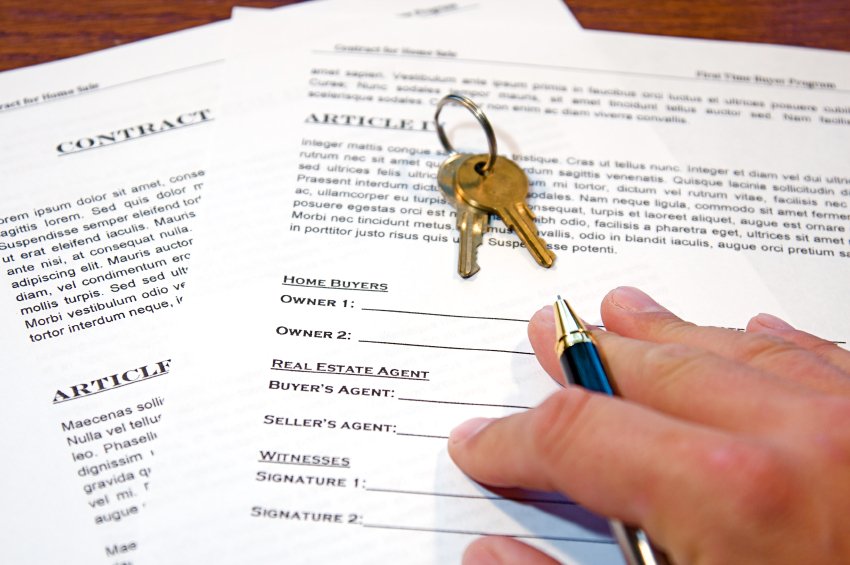
During the home-buying process, you’ll need to sign a real estate purchase agreement. This document can look quite formidable, and you may be tempted to sign it after giving it only a cursory glance. However, it’s in your best interest to carefully review this contract before you sign on the dotted line.
The real estate purchase agreement outlines every facet of your real estate transaction with the seller. Often this agreement is a standardized form in which the “blanks” are filled in with the specifics of your particular real estate transaction. However, a standardized document may not include everything you want in the transaction, so don’t assume everything is in there.
Make sure you read the agreement carefully before you sign it. You may want to have your attorney read it, too. Also, if you’re being represented by a real estate agent, make sure he/she is present when you sign the contract.
If you don’t fully understand something in the agreement, ask for an explanation. You can ask as many questions as you want. You need to be comfortable with this agreement.
Unless a specific phrase is required by state or local law, you can cross out and change any sentence you need to. Also, you can write in things that you feel were left out. Just make sure you initial any changes you make.
Important information included in a traditional real estate purchase agreement:
- Property address, parcel ID number(s) and legal description. If you’re purchasing an empty lot next to the lot containing the home, there should be more than one parcel ID number listed. If the property is in a rural area, include a property description addendum that contains the property boundaries or other landmarks.
- Buyer and seller names. Verify everyone’s name on the title report is named as a seller on the agreement. Each person must sign the final accepted offer. Also, if someone will be helping you with your mortgage, you need to include them on the purchase agreement or add the phrase “and/or assignee” after your name.
- Earnest money deposit. Usually, this amount ranges from $1,000 to 1% of the home’s purchase price. You can specify where this deposit will be held (at an escrow firm, at a bank or with an attorney) until the sale closes. Then this deposit becomes part of your down payment.
- Proposed purchase price and terms of sale. If the purchase price changes at any time during the loan process, you’ll need to have an addendum created, listing the new price. The appraiser will need this addendum, so they can update their report. If the purchase price is lower than the home’s appraised value, the price will be used to determine LTV ratios.
- Type of financing. If the type of loan changes at any time, an addendum is required.
- Personal property. The document will list what’s included in the sale, such appliances, window treatments, fans and other fixtures. Or, if the seller has any specific exclusions. However, make certain the appraiser doesn’t include personal property in the property valuation.
- Seller’s disclosures (things that affect the value of the property, such as previous basement floods, mold issues, termite infestation, etc). If there are any habitability or safety issues with the home, confirm the appraiser has commented on these issues in their report. If repairs are needed, the seller may to have to complete them before closing; otherwise, escrow may need to be held back.
- Type of deed transferring ownership of the property from the seller to the buyer.
- Closing date.
- Closing costs (an itemized list of what the seller and the buyer pay in fees associated with the sale).
- Property possession date. If the seller asks to stay in house after the closing date, or the buyer asks to move in before the closing date, the terms for the particular situation must be specified.
- Conditions that must be satisfied within a specific timeframe for the sale to go through.
- Seller’s responsibility to provide a clear title, meaning there are no claims or liens against the property.
- Provisions regarding who pays for title insurance, survey, termite inspections, etc.
- Details on adjusting real estate taxes or utilities between the buyer and the seller.
- Specifications concerning the buyer’s final walk-through of the home before closing.
- Contract expiration date. If the agreement is set to expire before closing, a contract extension is required. Make sure you read the addendum carefully to determine if you have to pay an extra fee for extension approval.
- Commissions, if any.
- Signatures.
As mentioned above, make sure you understand everything before you sign. Also, ensure the purchase agreement is as specific as possible since conflicts can arise at times, although they’re rare.
Long before you get to the purchase agreement process, you need to be pre-approved for a mortgage loan. Grandview Lending is a family-owned and operated residential home lender. Our mortgage specialists are skilled in helping you obtain a new home loan that meets your needs. Contact us today to start the loan process.
Photo credit: iStockPhoto
Do you know how much home you can afford?
Most people don’t... Find out in 10 minutes.
Today's Mortgage Rates

Leave a Reply